












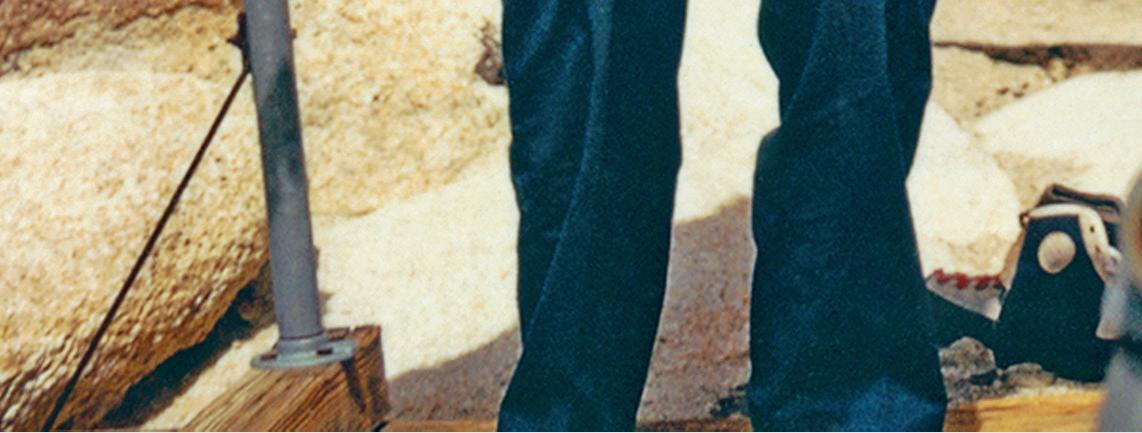















FOOD
Appetizers/Tapas
Asian Fusion
Bagel
Bakery
BBQ
Breakfast/Brunch
Burger
Business Lunch
Catering
Chinese Restaurant
Donuts
Fine Dining Restaurant
Food Truck
Gluten-Free Menu
Ice Cream/Frozen Yogurt
Indian/Nepali Restaurant
Italian Restaurant
Japanese Restaurant
Kid-Friendly Restaurant
Lyons Restaurant
Mexican Restaurant
New Restaurant
Niwot Restaurant
Overall Restaurant
Pancake/Waffle
Pizza
Place to eat outdoors
Place to go on a first date


Restaurant Dessert
Restaurant Service
Sandwich
Seafood
Sushi Restaurant
Take-out
Thai Restaurant
Veggie Burger
Wings
DRINKS
Bar
Beer selection
Cidery
Cocktails
Coffee House
Coffee Roaster
Craft Brewery
Distillery
Happy Hour
Latte/Mocha
Margarita
Teahouse
Wine Selection
CANNABIS
Bargains at a dispensary
Budtender
CBD Products
Edibles
Flower


CELEBRATING 42 years in business!
Medical Marijuana Dispensary
Recreational Marijuana Dispensary
Selection at a dispensary
Wax
HOME & GARDEN
Carpet/Flooring
Electrician
Florist
Furniture Store
Heating, Venting, and Air
Conditioning
Home Builder/Contractor
Home Finishing
Home Improvement
Hydroponic Store
Kitchen Supply Store
Landscaper
Mattress Store
Nursery/Garden Center
Painter
Pest Control
Plumber
Roofing Contractor
ENTERTAINMENT & CULTURE
Art Gallery
Bank/Financial Institution
Festival/Event
Live Jazz Venue
Museum








Music Venue
Non-Profit
Open Mic
Place to Dance
Place to Play Pool
Place to Wi-Fi
Private School
Public School (K-8)
Public School (9-12)
Sports Bar
FITNESS & HEALTH
Acupuncture Clinic
Barber Shop
Chiropractor
Climbing/Parkour Gym
Dance Studio
Day Spa
Dental Care
Golf Course
Gym/Fitness Center
Hair Salon
Hospital
Lasik Services
Martial Arts
Massage
Medical Doctor
Nail Salon
Orthodontist
Physical Therapist



Pilates Studio
Tanning Salon
Urgent Care Center
Veterinary Care
Yoga Studio
RETAIL
Auto Dealer - New Auto Dealer - Used Auto Service/Repair
Bicycle Shop
Bookstore
Car Wash
Clothing Store - Children’s
Clothing Store - Men’s
Clothing Store - Used
Clothing Store - Women’s
Business Owned/Led by Female CEO
Repair
Cleaner

Shopping Center
Stereo/Electronics
Storage Facility
Tattoo/Piercing Parlor
Tire Shop
Tobacco/Pipe Shop
Toy Store








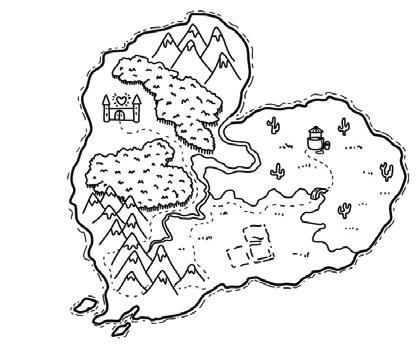














MICHA K.





BY MICHA K. BEN DAVID, GISELLE HERZFELD AND MICHAEL GAYNER
On the surface, building an overpass and underpass to allow safe crossing for bicyclists traversing a regional biking trail network seems like a great idea. Crossing busy streets on a bike can be dangerous, and if there’s one thing Coloradans can agree on, it’s how deeply we value
access to our beautiful outdoor landscapes.
But what if the landscape to which we are facilitating access happens to be one of the most radioactively contaminated areas in the country?
You may be familiar with the infamous Rocky Flats, a former nuclear weapons plant that produced 70,000 plutonium pits for nuclear bombs during the Cold War. The site was shut down in 1989 after an FBI raid uncovered an array of environmental crimes that left a 240,000year radioactive scar on our beautiful Front Range.
Only the area where the plutonium pits themselves were manufactured, known as the “central operable unit,” received a modest cleanup. It remains a designated EPA Superfund site to this day. The rest of the site was designated as a wildlife refuge that opened to the public
in 2018. Even before the refuge officially opened, local governments surrounding Rocky Flats began efforts to develop a biking trail encircling the most contaminated part of Rocky Flats, dubbed the “Rocky Mountain Greenway.”
At the heart of the debate are the dangers of the plutonium that exists in the area. Plutonium is widely understood as one of the most dangerous radioactive elements known to man, and for good reason. Inhaling even a tiny particle can lead to serious health issues, including cancer, immune deficiencies, birth defects and a wide array of other health problems. Proponents of the Greenway point to the fact that plutonium emits alpha radiation, which has a low range of radioactivity. At the particulate level, it can be rela-
AUGUST 15, 2024
Volume 31, Number 52
COVER: Tobin Sorenson slacklines a wire while fellow climbers Dean Fidelman and Gib Lewis look on. Credit: Kim Cooper
PUBLISHER: Francis J. Zankowski
EDITORIAL
EDITOR-IN-CHIEF: Shay Castle
ARTS EDITOR: Jezy J. Gray
REPORTER: Kaylee Harter
FOOD EDITOR: John Lehndorff
INTERN: John Kowalski
CONTRIBUTING WRITERS: Rob Brezsny, Michael J. Casey, Daniel Chang, Micha K. Ben David, Michael Gayner, Giselle Herzfeld, Courtney Johnson, Dan Savage, Alan Sculley, Niko Skievaski, Toni Tresca
MARKET DEVELOPMENT MANAGER: Kellie Robinson
SENIOR ACCOUNT EXECUTIVE: Matthew Fischer
ACCOUNT EXECUTIVES: Chris Allred, Tony Camarda
SPECIAL PROJECTS MANAGER: Carter Ferryman
MRS. BOULDER WEEKLY: Mari Nevar
CREATIVE DIRECTOR: Erik Wogen
GRAPHIC DESIGNER: Chris Sawyer
CIRCULATION MANAGER: Cal Winn
CIRCULATION TEAM: Sue Butcher, Ken Rott, Chris Bauer
BOOKKEEPER/ACCOUNT EXECUTIVE:
Austen Lopp
FOUNDER / CEO: Stewart Sallo
As Boulder County’s only independently owned newspaper, Boulder Weekly is dedicated to illuminating truth, advancing justice and protecting the First Amendment through ethical, no-holds-barred journalism and thought-provoking opinion writing. Free every Thursday since 1993, the Weekly also offers the county’s most comprehensive arts and entertainment coverage. Read the print version, or visit boulderweekly.com. Boulder Weekly does not accept unsolicited editorial submissions. If you’re interested in writing for the paper, please send queries to: editorial@ boulderweekly.com. Any materials sent to Boulder Weekly become the property of the newspaper. 1495 Canyon Boulevard, Suite CO 1, Boulder, CO 80302 Phone: 303.494.5511, FAX: 303.494.2585 editorial@boulderweekly.com www.boulderweekly.com
Boulder Weekly is published every Thursday. No portion may be reproduced in any form without written permission from the publisher. ©2024 Boulder Weekly, Inc., all rights reserved. Boulder Weekly welcomes your correspondence via email (letters@boulderweekly.com). Preference will be given to short letters (under 300 words) that deal with recent stories or local issues, and letters may be edited for style, length and libel. Letters should include your name, address and telephone number for verification. We do not publish anonymous letters or those signed with pseudonyms. Letters become the property of Boulder Weekly and will be published on our website.
tively harmless, as long as it stays outside your body.
The danger lies in the fact that there are widespread particles of plutonium onsite that can very easily enter the body through inhalation, ingestion or an open wound. When a plutonium particle becomes lodged in one’s body, it can wreak havoc at the cellular level. The particle is very likely to remain in the body for the rest of one’s life; it will continuously bombard surrounding cells with radiation. It may take years before a tumor develops, and by then one would have no idea it developed due to a scenic bike ride through a former nuclear weapons plant years prior.
Rocky Flats is a dry, dusty area, with virtually no signage to inform the public of the history and current contamination of the site. Thousands of people move to the Colorado Front Range each year with no knowledge of the history of the site, a history which has been effectively obscured from the public by the U.S. Department of Energy. By moving forward with this project, local governments risk potentially exposing thousands of unknowing people, including children and pregnant women, to plutonium and other radioactive materials.
got was only a partial cleanup totalling $7.3 billion and ending in 2005. That’s $30 billion dollars and 60 years of cut corners in cleanup, for all the mess that was created there.
As a result, the Rocky Flats area is still widely contaminated with plutonium particles, as well as other hazardous waste such as americium, beryllium, uranium and radioactive lead, among many others. Evidence shows that contamination is still widespread in the area, with materials that can remain radioactive for hundreds of thousands of years. Maps have been created to track the intensity, direction and shape of the plutonium contamination plume that stretches into the communities east of Rocky Flats.
In a significant recent scientific discovery, air testing by Dr. Michael Ketterer

The history of Rocky Flats is fraught with environmental scandals. Between 1952 and 1989, the Rocky Flats Plant experienced two major plutonium fires that blew radioactive particles across the surrounding metropolitan area, as well as a string of dangerously irresponsible waste disposal and storage failures — including the “903 pad,” where 5,000 metal barrels full of radioactive waste were left outside to corrode for 11 years, leaking all that waste into the ground and surrounding waterways.
After the site was shut down, full cleanup of the site was estimated by the Department of Energy to cost $36 billion and take 65 years. But what the public
of contamination threatens those investments for property owners and local governments — not to mention the potential liabilities.
The implications for similar locations around the United States — where contamination has been ignored, minimized or misconstrued — are incalculable. A defining moment in this history was conveyed by Dr. Carl Johnson, former executive director of Jefferson County Public Health, when he wrote a 1988 op-ed in the New York Times titled “Rocky Flats: Death Inc.” Johnson traced his history as a whistle blower warning of developing land downwind of Rocky Flats; he was subsequently fired.
A second, even more insidious interest in promoting the Rocky Mountain Greenway, is a desire to normalize and
proper cleanup and safe decontamination are granted a free pass to continue polluting without ever cleaning up their messes.
The tides may be turning as more local governments and organizations are stepping up to take a stand against the Rocky Mountain Greenway project.
In 2018, seven school districts banned field trips on Rocky Flats. In 2016, the Superior Board of Trustees rejected the Greenway project outright, and Broomfield voted unanimously to withdraw their support from the project in 2020. More recently, Westminster City Council held a July study session featuring expert presentations on the risks of moving forward with the Greenway project, which may foretell their withdrawal from the project.
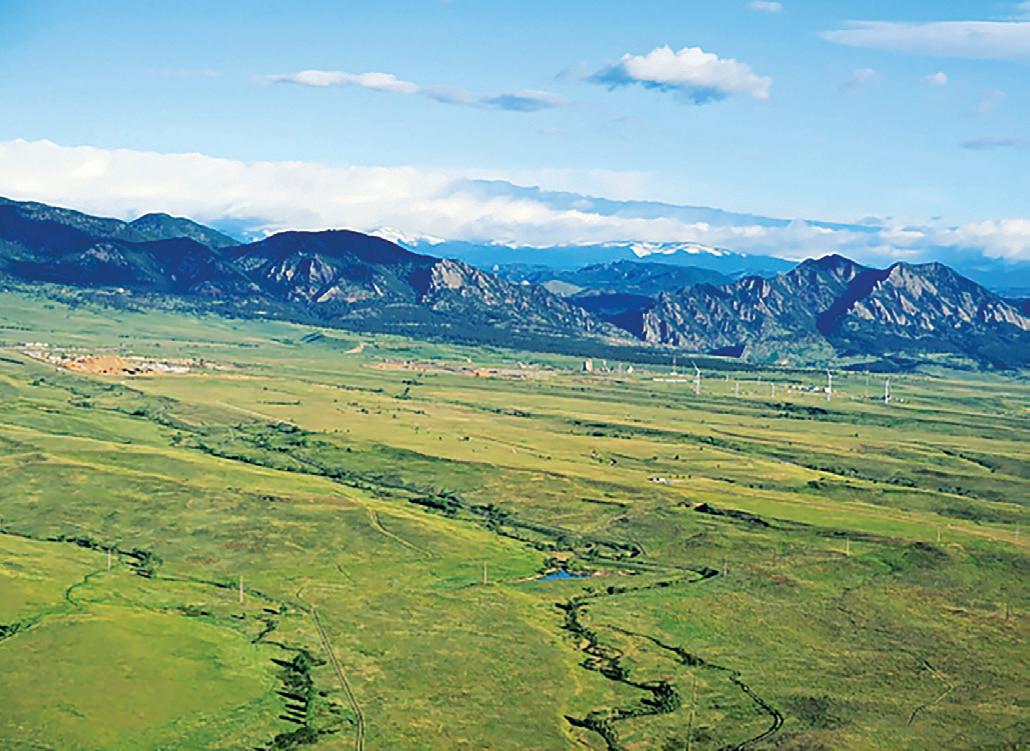
found airborne plutonium particles originating from Rocky Flats. Air filter samples were collected to the east of Rocky Flats during a high-wind event on April 6, 2024, and weapons-grade plutonium was detected in two samples. This study demonstrated that during high-wind episodes, contaminated soil is being carried across Rocky Flats and even offsite, with the potential to expose anyone downwind to plutonium inhalation.
The Colorado Front Range, with its vast scenic landscapes, is a rapidly growing area experiencing a major population and development boom. Enormous wealth has already been invested in housing and infrastructure in the neighborhoods around Rocky Flats. The truth about the level and danger
greenwash the production of nuclear weapons so that production can continue indefinitely.
As of 2021, the United States Congressional Budget Office has committed upward of $2 trillion over the next 30 years to modernize our nation’s nuclear weapons arsenal, a move which will require the production of new plutonium pits. A majority of this plutonium pit production is set to take place at the Savannah River Site in South Carolina, and the facility in which the pits will be produced is slated to cost $25 billion.
Normalizing former plutonium facilities as safe makes it easier to expand plutonium production to new sites. When a community accepts the presence of radioactive contamination and uses contaminated land for living and recreation, those who should be responsible for
Development of an overpass in Westminster and underpass in Boulder County linking Rocky Flats trails to a wider network of regional trails is set to move forward as early as Sept. 9, if no immediate actions are taken by the local governments involved. It is now more important than ever that these governments hear directly from their constituents that they do not want this project to move forward
Reach out to your elected officials and demand that they withdraw from the Rocky Mountain Greenway project to protect public health and safety. Together, we can ensure a safer, healthier future for ourselves and generations to come.
You can start by sending a letter: tinyurl.com/NoBoCoRMG
Members of the Rocky Mountain Peace & Justice Center, The Climate Justice Hive and The Nuclear Nexus contributed writing.
This opinion does not necessarily represent the views of Boulder Weekly.



I’ve lived in Boulder County since 2001. My father, an immigrant, worked tirelessly, taking on multiple jobs just to make ends meet. His first job in this country paid $5.15 an hour for cleaning offices. He moved from one minimum wage job to another. It took 12 years at the same company before his paycheck finally showed a raise. My family’s story is a testament to the harsh realities faced by many immigrants in Boulder County who are denied a liveable wage.
Municipalities across Boulder County are considering raising their minimum wage, an action that would benefit all in our community — especially immigrants like my father. A 2023 report by the Colorado Fiscal Institute highlighted the major disparities in wages for Colorado’s workforce. The study found that 37% of immigrants earn less than $37,800 a year, compared to 25% of their U.S.born counterparts. Many of these immigrants, who form a fundamental part of the fabric of our community here, work in essential jobs — construction, healthcare, agriculture and food, education and elder care — yet are still severely underpaid.
Even though the minimum wage today is higher than it was 20 years ago, it does not reflect the dramatic increase in the cost of living in Boulder County — costs immigrants bear unequally. Raising the minimum wage is not just an act of economic justice; it is an act of immigrant justice.
It’s time for municipalities across Boulder County to take a stand for both economic and immigrant justice. Let’s honor the hardworking individuals, like my father, who keep our community thriving by ensuring they earn a living wage.
— Keilly Leon is an organizer with Colorado Immigrant Rights Coalition
As a longtime reader of the Weekly, I too will miss Will Matuska. Thanks for your stellar reporting!
I recall reading most of the articles mentioned by staff in the July 25 publication. “Below our Feet” (July 25) was another excellent in-depth look into
groundwater in our state: very informative, and the article flowed well. One thing I found missing was that fracking was not mentioned as a big user of groundwater. The fracking drilling process uses millions of gallons of water for every new well. It is worth mentioning in a state with more than 58,000 oil wells.
As we face water shortages in the future, we should consider whether fracking is a good use of a limited resource.
— Eric Tussey, Boulder

Draco. The word has an ominous ring. And indeed, the proposed Draco well pad threatens Erie, a community already disproportionately impacted by years of intense drilling. A beyond-the-pale plan would site 26 wells just outside town in Weld County, with horizontal bores extending west for 5-plus miles to access minerals in Boulder County. (“26 new fracking wells planned near Erie,” July 24)
Directly in the path of danger are many of Erie’s densely populated neighborhoods, heavily dotted with existing wells. Draco puts those wells at risk for disruption, and they are slated to be plugged to avoid potential catastrophes. The plug and abandonment process is in itself a difficult undertaking, often taking years to remediate the environmental damage done.
More pollution from Draco’s emissions, further degrading the region’s air quality. More water wasted, with over 500 millions gallons of a scarce and precious resource permanently poisoned by the chemicals used to hydraulically fracture Draco’ s wells. And more expansion of infrastructure, when the climate crisis calls for us to rein in — not ramp up — oil and gas development.
Had enough of the fossil fuel frenzy? To learn more, please visit the Erie
website at
com, and join the residents fighting to stop Draco and keep our neighborhoods safe and healthy at the Erie Community O&G Monitoring and the Flatiron Meadows O&G Monitoring group pages on Facebook.
— Liz Fisher, Erie
After reading “Boulder planning ‘road diet’ for Iris Avenue” (Aug. 8), I saw the proposed new design with a two-way protected bike lane. The design may look good but actually creates serious new risks.
Some years back, I found out that a similar approach at 29th and Baseline has a high accident rate. [Editor’s note: Baseline has a one-way bike lane and multi-use path near 29th.]
What they don’t realize is that bikes heading east may enter that crosswalk at 8 mph (or higher) and those bikes appear unexpectedly because drivers don’t see them; the bikes are in a blind spot, coming from behind and two car lanes over.
From the bicyclist perspective, they are traveling at a reasonable speed. They likely see cars at the intersection or turning right onto 29th. What they don’t see or expect are cars two lanes over doing left turns from Baseline onto 29th.
Cars and bikes that don’t see each other but are crossing paths is exactly the recipe for accidents. The two-way bike lanes proposed on the north side of Iris are creating this same accident risk. As long as the intersections are uncontrolled, the risk is there.
It can be fixed with a traffic signal, with a left turn green arrow when car and bike lane traffic is stopped, but I doubt the city would do this at most intersections. It is better to simply avoid two-way bike lanes near traffic and use bike lanes that move in the same direction as traffic.

Separately, instead of barriers, the city should consider something like the rumble strips that are used in Boulder Canyon that signal to a driver when they cross the center line. They would signal to the driver when he drifts into the bike lane.
Lee Gilbert, Boulder
*Baseline Safety Improvements event: 4-6 p.m. Monday, Aug. 19, at the Boulder Public Library Meadows Branch (4800 Baseline Road). Info: bit.ly/BaselineBW
I am part of a group of people who live adjacent to Iris Avenue in Boulder who are concerned about the impact that a road diet on Iris will have on our neighborhoods. We are concerned that a road diet will lead to increased traffic as impatient drivers turn to alternate routes, through which they will likely speed, and care less about the impact they have on the communities that exist there. As more cars are diverted through these neighborhoods, the core of our communities — children running about and playing — will begin to erode and degrade, tacitly forcing those kids off the neighborhood streets and back in front of their video game consoles, and their televisions.
We have raised these concerns with the city planners, and we have been dismissed out of hand with platitudes that there will be no impact. We now know that the city plans to put traffic calming devices on Kalmia and on Glenwood, both key streets that run parallel to Iris. To me, this looks prima facie that the city knows there will be an increase in neighborhood traffic.
Proponents of road diets claim their efforts are to make transit safer for pedestrians and cyclists. We who live in the affected neighborhoods want to know: What about the safety and well being of our children and of our neighborhood?
If you share these concerns and have here-to-fore remained silent, or if these ideas are new to you, I urge you to write to your city council members to voice your concern. Absent any tangible action, I urge you to consider voting in future elections for people who value our voices and concerns.
— Phil Smith, Boulder


Bans could deny teenagers mental health help, experts say
BY DANIEL CHANG KFF HEALTH NEWS
Social media’s effects on the mental health of young people are not well understood. That hasn’t stopped Congress, state legislatures and the U.S. surgeon general from moving ahead with age bans and warning labels for YouTube, TikTok and Instagram.
But the emphasis on fears about social media may cause policymakers to miss the mental health benefits it provides teenagers, say researchers, pediatricians and the National Academies of Sciences, Engineering and Medicine.
In June, Surgeon General Vivek Murthy, the nation’s top doctor, called for warning labels on social media platforms. At least 30 states have pending legislation relating to children and social media — from age bans and parental consent requirements to new digital and media literacy courses for K-12 students.
Most research suggests that some features of social media can be harmful: Algorithmically driven content can distort reality and spread misinformation; incessant notifications distract attention and disrupt sleep; and the anonymity that sites offer can embolden cyberbullies.
But social media can also be helpful for some young people, said Linda Charmaraman, a research scientist and director of the Youth, Media & Wellbeing Research Lab at Wellesley Centers for Women.
For children of color and LGBTQ+ young people — and others who may not see themselves represented broadly in society — social media can reduce isolation, according to Charmaraman’s research, which was published in the
Handbook of Adolescent Digital Media Use and Mental Health. Age bans, she said, could disproportionately affect these marginalized groups, who also spend more time on the platforms.
“You think at first, ‘That’s terrible. We need to get them off it,’” she said. “But when you find out why they’re doing it, it’s because it helps bring them a sense of identity affirmation when there’s something lacking in real life.”
Arianne McCullough, 17, said she uses Instagram to connect with Black students like herself at Willamette University, where about 2% of students are Black. After about a month at Willamette, McCullough assembled a social network with other Black students.
“We’re all in a little group chat,” she said. “We talk and make plans.”
and things that I wasn’t self-conscious of before.”
When her mother tried to take away the smartphone, McCullough responded with an emotional outburst. “It was definitely addictive,” said her mother, Rayvn McCullough, 38, of Sacramento.
Arianne said she eventually felt happier and more like herself once she cut back on her use of social media.
But the fear of missing out eventually crept back in, Arianne said. “I missed seeing what my friends were doing and having easy, fast communication with them.”
groups to prioritize funding such studies.
Some states have considered policies that echo the national academies’ recommendations. For instance, Virginia and Maryland have adopted legislation that prohibits social media companies from selling or disclosing children’s personal data and requires platforms to default to privacy settings. Other states, including Colorado, Georgia and West Virginia, have created curricula about the mental health effects of using social media for students in public schools, which the national academies also recommended.
Social media hasn’t always been this useful for McCullough. After schools closed during the pandemic, McCullough said, she stopped competing in soccer and track. She gained weight, she said, and her social media feed was constantly promoting at-home workouts and fasting diets.
More young people were reporting feelings of hopelessness and sadness, as well as suicidal thoughts and behavior, according to behavioral surveys of students in grades 9 through 12 conducted by the Centers for Disease Control and Prevention.
The greater use of immersive social media has been blamed for contributing

“That’s where the body comparisons came in,” McCullough said, noting that she felt more irritable, distracted and sad. “I was comparing myself to other people
to the crisis. But a committee of the national academies found that the relationship between social media and youth mental health is complex, with potential benefits as well as harms. Evidence of social media’s effect on child well-being remains limited, the committee reported this year, while calling on the National Institutes of Health and other research
The Kids Online Safety Act, which is now before the House of Representatives, would require parental consent for social media users younger than 13 and impose on companies a “duty of care” to protect users younger than 17 from harm, including anxiety, depression and suicidal behavior. The second bill, the Children and Teens’ Online Privacy Protection Act, would ban platforms from targeting ads toward minors and collecting personal data on young people.
NetChoice, an industry group whose members include Meta and Alphabet, which owns Google and YouTube, has filed lawsuits against at least eight states, seeking to stop or overturn laws that impose age limits, verification requirements and other policies aimed at protecting children.
Much of social media’s effect can depend on the content children consume and the features that keep them engaged with a platform, said Jenny Radesky, a physician and a co-director of the American Academy of Pediatrics’ Center of Excellence on Social Media and Youth Mental Health.
Age bans, parental consent requirements and other proposals may be wellmeaning, she said, but they do not address what she considers to be “the real mechanism of harm” — business models that aim to keep young people posting, scrolling and purchasing.
“We’ve kind of created this system that’s not well designed to promote youth mental health,” Radesky said. “It’s designed to make lots of money for these platforms.”
Chaseedaw Giles contributed to this report. KFF produces in-depth journalism about health issues
What your local officials are up to this week
BY KAYLEE HARTER

At the Aug. 22 study session, council will discuss:
• The scope, schedule and engagement strategy for the next major Boulder Valley Comprehensive Plan (BVCP) update. The BVCP is a longrange plan for land-use decisions in the community that requires an update every 10 years. The next major update is set for 2025, and the process will begin with an Oct. 19 community kickoff event, according to a council memo.
• Enacting a local minimum wage in Boulder. State legislation passed in 2019 allowed for local governments to set their own minimum wages; unincorporated Boulder County, Denver and Edgewater have since adopted local minimum wages. Boulder County raised its minimum wage to $15.69 in January 2024, and Denver’s 2024 minimum wage was $18.29. Currently, Boulder’s wage matches the state minimum wage at $14.42. At the study session, council will weigh in on a target wage and how much to increase wages each year if it chooses to pursue a local minimum. There will be no meeting Aug. 29.
During the week of Aug. 19:
• Commissioners will hear a presentation on the District Attorney’s recommended budget (Aug. 20, 9:30 a.m.).
• The Planning Commission will take public testimony and make a
recommendation to the commissioners on allowing Zeke’s Quality Cannabis LLC to operate in North Boulder at 5853 N. Rawhide Court (Aug. 21, 1:30 p.m.). The company will manufacture infused pre-rolls and edibles, according to its application.
• Hold a public hearing on proposed changes to the Boulder County Land
Use Code, including streamlining the process for subdivision exemptions and exemption plats, which allow residents to propose changes such as boundary line adjustments and lot mergers. If approved, public hearings would no longer be required for such changes; decisions would be made at the staff level.



























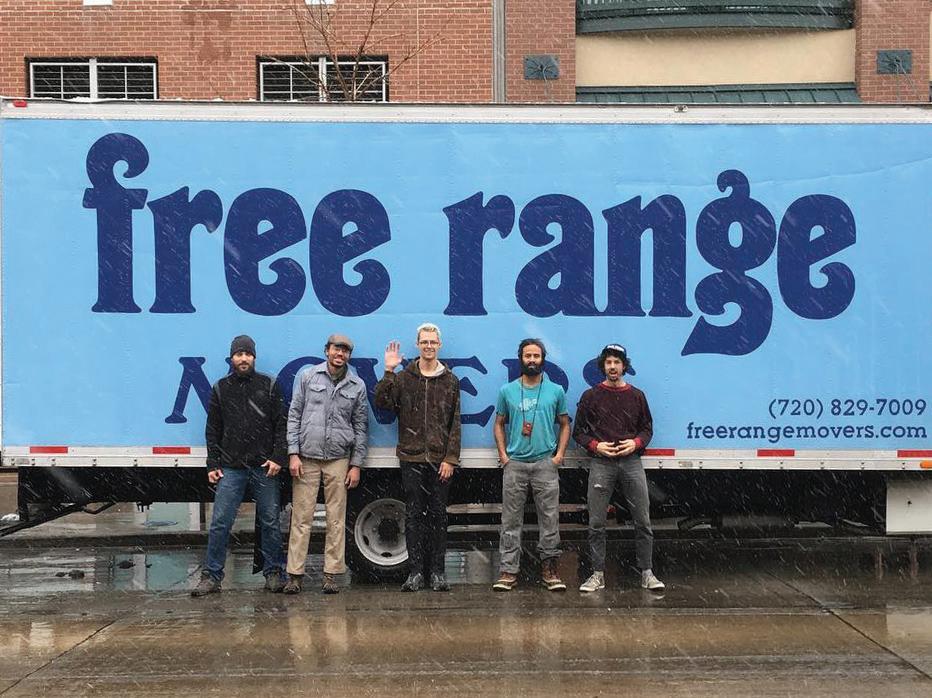




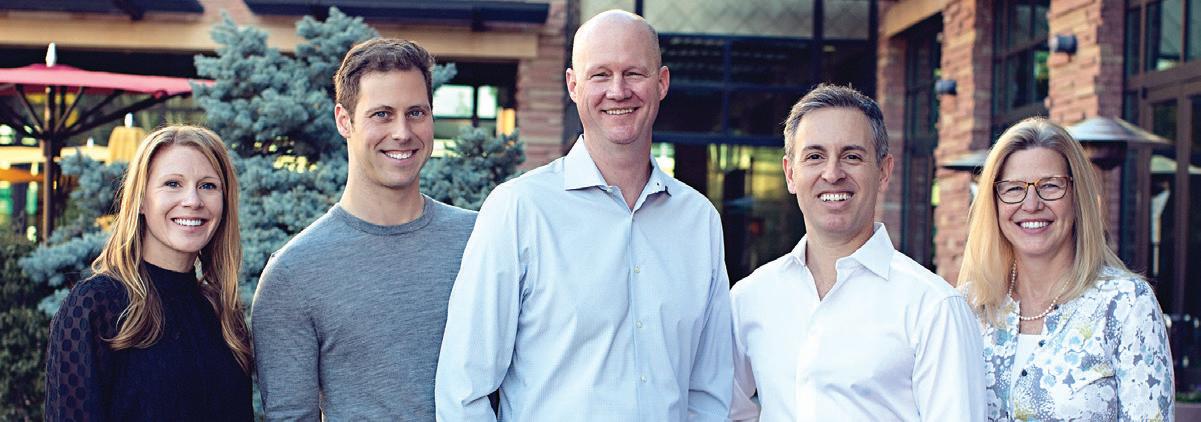






































news at a glance
BY SHAY CASTLE
The City of Boulder must release video footage from the police shooting of Jeanette Alatorre for free, a Boulder County judge ruled Aug. 12.
Attorney Dan Williams requested the body cam footage the day after the Dec. 17, 2023, fatal incident. Boulder officials said it would cost $8,484 for the full video and $1,425 for 13 minutes surrounding the shooting.
Yellow Scene magazine and Alatorre’s daughter, Angelica Jeannette Orozco, also requested the footage and were told that it would not be released until the city was paid, after which they filed the suit.
Governments can charge for the release of documents and other records.
But as District Court Judge Robert Gunning wrote in his ruling, this particular footage is governed by a different and distinct law: the Enhance Law
Enforcement Integrity Act of 2020, passed in response to the police murders of George Floyd and Elijah McClain.
“The Integrity Act … mandated the
prompt public release of unedited footage and other recordings of any incident following a complaint of police misconduct,”
Gunning wrote. “The plain language of the statutes does not authorize Boulder to impose a fee,” and the bill’s sponsor, Rep. Leslie Herrod, in 2021 specifically stated that the legislation “was never intended to authorize agencies to charge fees for releasing footage to the public.”
“Boulder’s use of exorbitant fees to shield the video of its police officers killing Ms. Alatorre is part of a disturbing trend at BPD of resisting transparency,” Williams wrote in an emailed statement to Boulder Weekly. “We hope Boulder will reflect on this ruling and pivot to accepting public accountability moving forward.”
Read more: bit.ly/BodyCamBW
A committee of 31 Boulder and Weld County Democrats picked Jillaire McMillan to run for Colorado House District 19 after incumbent Jennifer D. Parenti, who appeared on primary ballots, ended her reelection campaign.
McMillan owns a small robotics company with her husand and lives in Longmont, according to her LinkedIn profile. She also works for religious advocacy organization Mormons for Ethical Government.
HD19 straddles Boulder and Weld counties and includes Frederick,

Firestone, Dacono and portions of Longmont and Erie.
In a statement shared by Colorado Democrats, McMillan said she has “been considering public office for a long time.”
McMillan will face former Republican lawmaker Dan Woog, of Erie, who was ousted by Parenti in 2021.
Three teenagers were injured in an Aug. 9 shooting on Boulder’s University Hill. The youth — two 17 year olds and an 18 year old — were attending a “large party” near the corner of Euclid and 14th Ave., according to information from police, and received nonspecific injuries to their arms and legs.
Suspects had not been named as of Wednesday morning. An investigation is ongoing, and police are seeking video of the incident.
• CU Boulder students officially move in starting Aug. 19. More than 7,000 first-year students will arrive on campus from Aug. 19-22, according to the university. Classes start Monday, Aug. 26.
• A formal agreement between CU Boulder and NASA was signed last week to advance research in space weather, which “can harm spacecraft, astronauts and essential technology on Earth,” according to a CU press release.
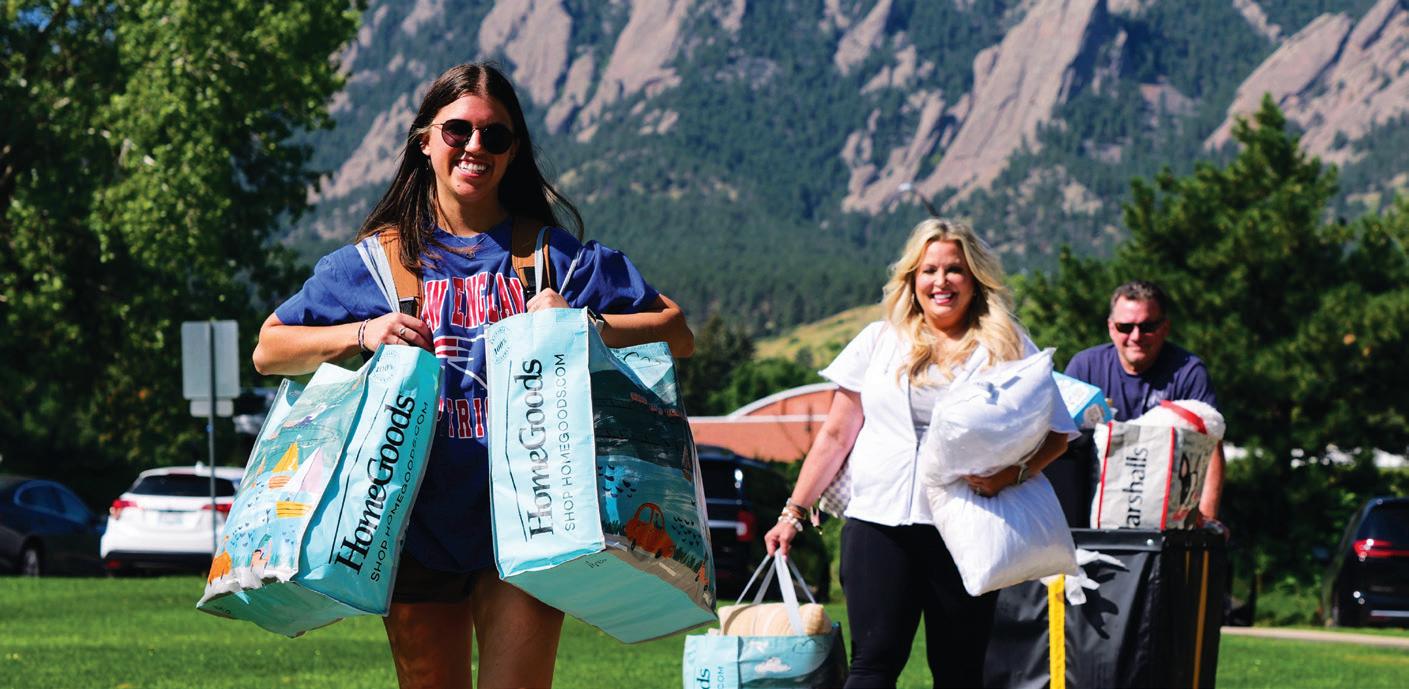


Local author explores the life and legacy of ‘the best climber in the world’
BY ZOE JENNINGS
In the 1970s, a group of long-haired hippie kids escaped the sprawl and smog of Los Angeles to climb rocks in the wilderness. They called themselves the Stonemasters.
Boulder local Rick Accomazzo recounts his experiences with the scrappy collective — alongside unpublished writings and documentation of his climbing partner, who died on a dangerous free solo climb at 25 — in his new book, Tobin, the Stonemasters and Me: Remembering Tobin Sorenson, the Best Climber in the World
“Tobin’s full climbing career has never been told, only bits and pieces,” Accomazzo says. “A lot of Tobin’s story was really my story of climbing. We were regular climbing partners. I had some of my best climbs with him.”
The book begins with the early days of climbing in Joshua Tree, where the high school students made their first ascents while building a culture around being “nonconventional misfits.” This combination made for a lot of good stories, but as Accomazzo writes: “In the climbing world, there is a very thin line between a good story and the end of earthly existence.”
The chapters are organized geographically and include anecdotes of each location and its gravity-defying climbs. One section details Tobin’s Colorado adventures, including ascents in Eldorado Canyon and Estes Park. The chapters, which can be read as independent stories, feature large, high-resolution photos for reference.
This adrenaline-seeking bent fueled a certain spirit of debauchery among the young climbers, but Tobin was different from other
Stonemasters. The straight-laced preacher’s son befriended most people with an easy joviality, but surprised rock climbers for generations to come with his skill and fearlessness.
One of those climbers was Alex Honnold, the first person to free solo a route up Yosemite’s El Capitan in 2017, who regards the late adventurer as one of his idols. Accomazzo, who



recently stepped back from law practice, supports in his book the bold claim that Tobin was the best climber in the world. Prepared to take flak from climbing enthusiasts and the foreign press, he includes a spreadsheet of the extensive and daring climbs made during his short life.
“I picked the provocative title that he was the ‘best climber in the world,’ but I’m
a lawyer: I have assembled the evidence,” Accomazzo says. “If somebody could come up with a better list of the first ascents that Tobin did over his climbing career, I will reconsider it. A lot of people were really good at alpinism. A lot of people were really good at rock climbing. Nobody could go from one to the other consistently; and Tobin did that.”
Tobin’s brother Tim Sorenson remembers his older sibling’s fake Beatles cover band, complete with cardboard guitars, shaggy wigs and lip syncing. Tim always wanted to join, but they were all set with four members. He would spend the rest of his life looking up to his big brother, waiting for his chance to join the proverbi al band.
That moment came when Tobin intro duced Tim to climbing. He remembers training before modern climbing gear and gyms. They practiced using bolts fastened to the side of their chimney and pitons on the sides of trees. They repelled off cliffs with electrical cords. Their greatest teach ers were long falls from cliffs and occa sional impacts with the ground.
Tobin wasn’t afraid of those long falls. That’s part of what fascinated Accomazzo in telling the story of his fearless friend and the jaw-dropping heights he achieved. “The book explores the mystery of why he had such an appetite for risk,” the author says.
Some speculated that Tobin felt he had a “top rope from God” to protect him on difficult climbs, according to Accomazzo. The book includes many stories about his reputation for religious piety, often being the only Christian in the group.

“The popular thinking of some was that Tobin was this over-religious guy, who believed he would never die in the mountains because of his deep religious faith,” Accomazzo says.
Tobin attended Biola College, a Bible institute in Los Angeles. Many of his international climbs were funded in part by missionary efforts, including smuggling bibles into Bulgaria, which positioned him for his ascents in the Alps.
“He was not like the angry evangelicals of today,” Accomazzo says. “He was a very compassionate religious guy who wanted to do good in the world and cared for everybody. He made friends with everybody.”
Although most knew Tobin as an outgoing guy who easily garnered help and places to stay from strangers aiding in his climbing pursuits, Tim knew his brother’s quiet side.
“Tobin was very introspective,” Tim says. “He really examined his faith and
summer school with a local missionary group in 1980. He wrote to his fiance, who was planning to join him at the end of summer, before his last climb. The book includes unpublished excerpts from his letters to Elizabeth. Tobin admitted he wasn’t sure if he’d survive his planned ascent of Mount Alberta’s North Face. He died from a fall during the attempt.
As a fellow climber, Tim knew the risks his brother took. He continued to climb after the accident, partly as a way to feel closer to his departed sibling.
“I just had that feeling like I connected with him when I climbed,” Tim says. “There are a lot of people that feel close
to Tobin, even though they really didn’t know him that well, or even if they had never met him, because of the spirit he exuded when he was climbing. He had a reputation for that lightheartedness and joy.”
ON THE PAGE:
Tobin, the Stonemasters and Me reading with Rick Accomazzo 6:30-8:30 p.m. Thursday, Aug. 22, Neptune Mountaineering, 633 South Broadway, Boulder. Sold out. Waitlist: bit.ly/StonemastersBW
his motivations. There’s a point in his climbing, about a few years before his death, that he looked at himself and had some self-examination. He felt a higher calling besides just climbing.”
Much of the book covers the last three years of Tobin’s life, and the height of his climbing career. From climbs in Australia to Peru, his landmark season started in 1977 after scaling the Alps with Accomazzo in 1976. During this time, Tobin completed four new routes on the Great North Faces of the fabled European mountain range.
“Nobody else has done four new routes in one season on the Great North Faces, by their hardest routes,” Accomazzo says. “It made somewhat of a splash.”
Tobin was engaged to marry before moving to Edmonton, Canada, to teach








BY ALAN SCULLEY
The latest project from Shakey Graves is a choose-your-ownadventure story.
Following the release of his fourth album Movie of the Week, the celebrated folk-rock artist — whose given name is Alejandro Rose-Garcia — launched a website giving listeners access to the wealth of material left on the cutting room floor. With the help of an AI generator, fans can rearrange the tracks ad infinitum to create their own unique edition of the record paired with a fictitious film synopsis created by a user-submitted prompt.
“Each song has probably five to eight different versions. Then there’s all of this other stuff that’s not on [Movie of the Week], whole other albums,” Rose-Garcia says. “You’re going to be able to endlessly scramble the album into unique soundtracks, and then if you want, you can purchase them and we’ll send you the files and you’ll have your own version. “It might organize it in a way that I could have never thought of,” he continues. “There’s so much stuff. I need to get it out.”
Movie of the Week was initially intended to be an actual film soundtrack. Some friends were making a movie and asked Shakey Graves to pen the soundtrack.
But the director rejected some of the music, so Rose-Garcia began to formulate the idea of expanding on the material and turning it into a soundtrack to an imaginary movie.
“I wanted to go into the recording studio and try to make songs based on a plot. I had some melodies and demos and stuff,” he says. “The plot of the movie was [about] someone from the middle of nowhere who kind of burns out, then looks on a map and kind of decides to go somewhere that sounds fancy. He chooses Century City. That’s the spot. Like, everything’s going to be better in the
future. And then it’s like a road trip movie. Then when he gets to Century City, he comes to find out it’s parking lots for other parking lots.”
Working with the same six-piece band he took on tour to promote Movie of the Week, Rose-Garcia recorded lots of material before he began to figure out which versions of which songs would be included in the project.
“The album is the most centered those songs get,” he says. “Those [other] versions that are coming out, they get longer and weirder and rougher around the edges. All of that will exist in the world, too. But I wanted to show where at least the home base of this is, the kind of sonic unity.”
The most recent Shakey Graves LP is Rose-Garcia’s most pop-leaning effort to date. Songs like “Evergreen,” “Century City” and “Limbo” are replete with rich
melodies that are soft around the edges. Meanwhile, “Ready Or Not” (featuring Sierra Ferrell), “Play Where It Lies” and “Playing Along” are among a few more spare songs that feel more intimate, but also a bit edgier than the rest of the album.
Movie of the Week marks another singular statement for the 37-year-old artist who broke onto the national scene in 2012. After starting out pursuing acting with roles in Friday Night Lights and Spy Kids 3, his stark and intimate debut album, Roll the Bones — re-released in 2021 with a bevy of unreleased material — quickly established Shakey Graves as a fresh voice on the folk scene.
Rose-Garcia’s next full-length release, 2014’s And the War Came, started to expand on his style, adding drums and other instrumentation while retaining his spare, ramshackle folk sound. The years since have found him pushing the envelope further with the highly produced 2018
album, Can’t Wake Up, continuing a tradition of pushing his once-solo project into new sonic territory.
Considering the depth and breadth of his previous output, it makes sense that Rose-Garcia plans to touch on all phases of his career during his upcoming set in support of Tyler Childers at CU Boulder’s Folsom Field on Aug. 17. He’ll play solo during the show — recalling the one-man-band approach of his early tours, using a jiggered suitcase as a drum — and, of course, with a band he says is the best unit he’s had.


“Obviously, some of the more large, bombastic production stuff I’ve made over the years has never sounded better,” Rose-Garcia says of playing with his band. “But then also they’re fabulous musicians, so playing these old, more sensitive kind of homestudio stuff, they’re able to do that, too.”
Like the AI project extending the life of Movie of the Week, fans can also expect Graves to be spontaneous on stage and continue his tradition of rearranging and reinventing songs in the moment.
“Just to keep our mood different or to suit the room, we’ll play certain things in a variety of ways,” he says.
“We recorded a lot of [Movie of the Week] live and didn’t build a lot of stuff. We just learned how to play it. We’re really going to try to at least start close to what it’s supposed to sound like.”
ON THE BILL: Tyler Childers with Shakey Graves. 5:30 p.m. Saturday, Aug. 17, CU Boulder - Folsom Field, 2400 Colorado Ave. $78+




BY MICHAEL J. CASEY

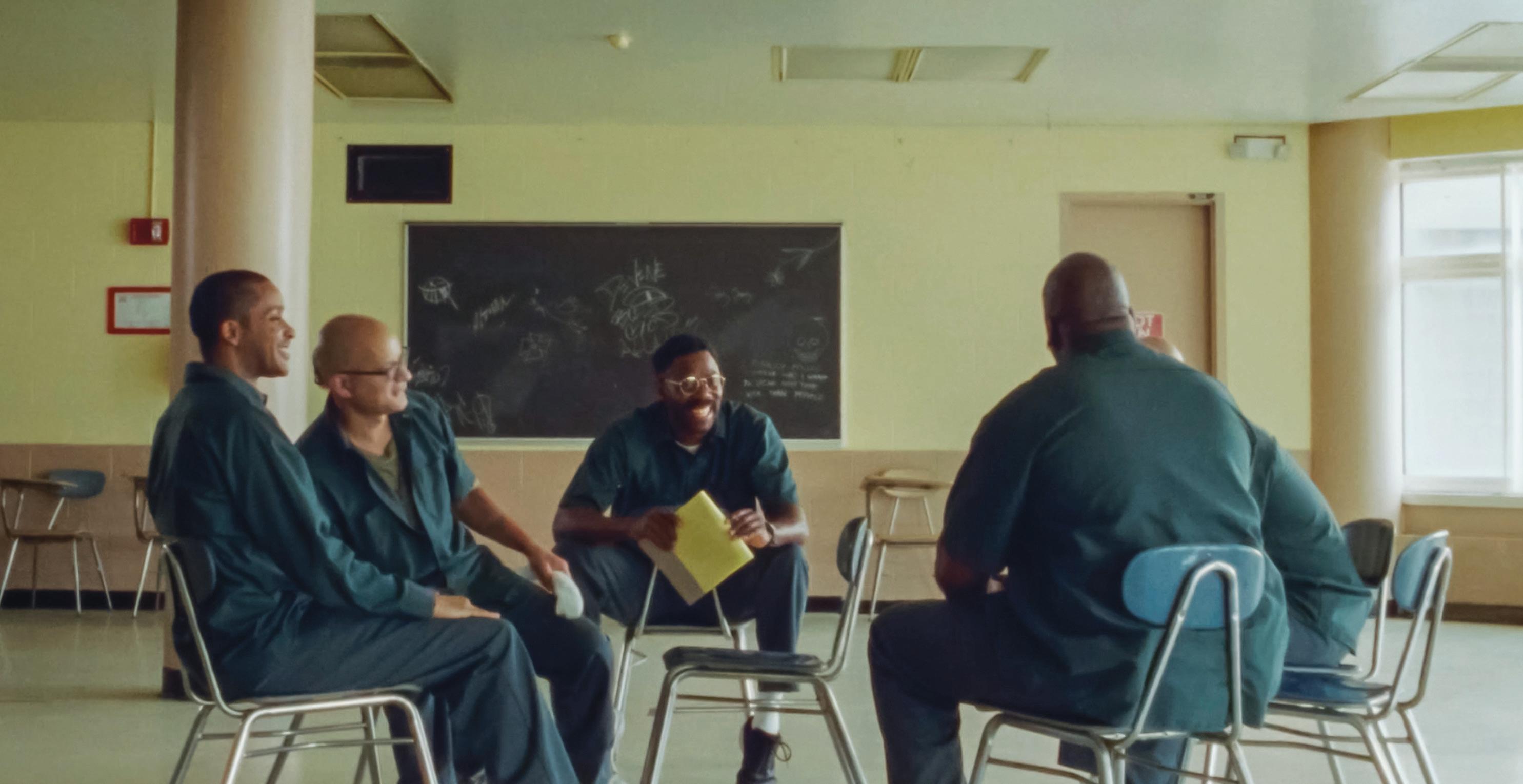
Of the many cruelties of our carceral system — and there are many — the stoppage of time seems especially callous. Think of your schedule so far today: the things you did, the places you went, the freedom to move between them. How much time did you spend thinking about what you’re going to do tomorrow and tomorrow and tomorrow?
Now consider what it would mean, emotionally, spiritually, physically, if all those tomorrows evaporated into a confining concrete box of rigorous structure and little hope of a fresh start. Would it break you?
For many, the answer is yes. For the participants of Rehabilitation Through the Arts (RTA) at New York’s Sing Sing Correctional Facility, performance is the way to keep the break at bay. As one RTA player describes, prison desensitizes and dehumanizes the man. RTA reverses that. And that’s all he wants. All he needs.
Directed by Greg Kwedar and based on John H. Richardson’s 2005 Esquire article, Sing Sing chronicles one season
in the RTA as the actors rehearse and perform Breakin’ the Mummy’s Code, a time-traveling comedy featuring ancient Egypt, Robin Hood, a Wild West shootout and Hamlet’s “to be or not to be” soliloquy. How this script comes to be is one of Sing Sing’s funniest scenes.
Colman Domingo plays John “Divine G” Whitfield, unjustly imprisoned for seconddegree murder, and RTA’s resident playwright and most ardent supporter. Divine G is looking for new talent and sees it in the tough-as-nails gangster who can quote King Lear: Clarence “Divine Eye” Maclin (playing himself).
Like many of the performers in Sing Sing, Maclin is formerly incarcerated and an alumni of the real-life RTA (which continues to this day). Their participation brings an authenticity the narrative could not do without. There are professionals in Sing Sing — Domingo and Paul Raci, who plays the RTA director, are probably the most recognizable — and they are pitch-perfect in every way. But it’s the real-life graduates of RTA who hold the
frame with dignity and delight. To watch them at work is a wonderful thing. In a stunning way, Sing Sing is a continuation of that process.
The film is stunning, pure and simple. It refrains from providing reductive truths and easy answers — particularly with Divine G. In any other movie, Divine G would be in opposition to his fellow inmates, armed with more than a few speeches about miscarriages of justice. But Kwedar and co-screenwriter Clint Bentley don’t take the bait. Instead, they place Divine G side-by-side with his fellow inmates, each leaving their own breadcrumb trail of fates unfair. Some were born into the life; others fell into ones that offered little chance out. In one scene, Divine Eye points out that if his friends are behind bars, his son is behind bars and he’s behind bars, maybe this is where he belongs. In another scene, Mike Mike (Sean San José) gives a sense that a healthy family life was available to him on the outside, but drugs got the better of that one.
Framed like that, you might think Sing Sing is a by-the-numbers, feel-good story about overcoming. It’s not, even if the movie, top to bottom, will fill you with goodness and hope. A lot is thanks to the performances, but don’t overlook Kwedar’s graceful touch and cinematographer Pat Scola’s artistic simplicity that informs rather than decorates. You may not notice them, but many shots employ unfocused, abstract images to slow down the narrative so the audience can digest information. It’s a touch of the poetic that never feels intrusive.
There’s a real harmony between the artists in front of and behind the camera to create something moving, something lasting here. A lot of movies, a lot of good movies, come and go. Sing Sing will stick.
places from her past that still linger in her mind. In 2018, the Colorado-based artist began experimenting with a style of work known as image-transfer — which uses laser printing to transpose an image to another medium — because she was fascinated by the “haunting” quality it gave to her large-scale paintings of decaying houses, eerie rock formations and clandestine passageways.
Her large-scale pieces capture the beauty of abandoned structures in rural America, creating a sense of place that is both specific and universal.
group art show gets nostalgic on The Hill
BY TONI TRESCA



On a balmy summer afternoon, Boulder’s University Hill buzzes with the youthful energy of a college town. Students spill out of local establishments, their chatter echoing through the streets, while music thumps from nearby houses. Amid this lively scene, tucked away on Pennsylvania Avenue, the Nick Ryan Gallery is an oasis of calm.
Inside, the gallery’s upcoming exhibition, Recollections, invites visitors to step back from the chaos and into the quiet contemplation of memory and nostalgia. Opening Aug. 16, this late-summer group show features four artists — Jessica Rohrer, Andrew Watel, Brenda Stumpf and Daniel Granitto — who incorporate personal and collective reflection into their representational works.
The gallery was founded by CU Boulder graduate Nick Ryan, who got his start at the Boulder-based MacLaren Markowitz Gallery and spent nearly two decades honing his curatorial skills at Denver’s William Havu Gallery. His new multi-level space opened its doors in May with Polyphony, a solo exhibition by Denverbased Bruce Price.
“It has always been my dream to open a gallery here,” Ryan says. “Boulder is a beautiful city, but it has lacked a premier commercial gallery. Since no one else was

stepping up, I decided to take the lead.”
Ryan’s vision is to showcase compelling works by regional and national artists to foster dialogue between the local community and the larger art world. In Recollections, that conversation centers on how memory influences artistic expression, with each artist drawing on their history to create something new.
Jessica Rohrer’s work in Recollections
offers a glimpse into the cookie-cutter landscapes many suburbanites know intimately. The Yale-educated painter was inspired by drone images of her New Jersey neighborhood, capturing the gridlike precision of residential streets from a birds-eye view.
“I’ve always painted what I see around me,” Rohrer says. “Once I moved to the suburbs, I started painting the neighborhood. Eventually, I started using drone images to see the environment from a different perspective.”
Rohrer’s meticulous approach to her work is evident in the degree of detail. Whether it’s the slightly askew horizon lines or the voyeuristic view from her window, her paintings evoke a sense of famil-
iarity while also inviting viewers to see the suburban landscape through her eyes.
“Even though I am painting a particular place, you wouldn’t know it’s New Jersey from looking at my work,” she says. “The idea is that anyone could resonate with them and be reminded of an area in the suburbs they recognize or grew up in.”
Memory is also essential to the process of fellow exhibiting artist Andrew Watel. The Kansas City-based creative specializes in dramatic, somewhat abstract drawings and paintings of everyday household objects — a simple spring or an air filter — which are more about his personal experiences with these items than what they do.
“People may look at these objects and not think they’re beautiful, but I do,” Watel says. “They have no meaning outside of their function. Everything I paint is very simple. Later on, I often wonder why I chose these things, but that is only after the fact. In the moment, it is more about what items I am drawn to and what I remember.”
Like the other artists in Recollections, Brenda Stumpf transports viewers to the
“Even though I have my ideas about the work, it’s so nice that people can walk up and have their relationship with it,” Stumpf says. “I’m always curious about what happens when you take your work out of the studio and put it in a different context — it allows you to experience the work in a new way.”
Daniel Granitto’s work in Recollections is also deeply rooted in places he knows well, often beginning with a photograph but extending far beyond mere visual likeness. His paintings strive to capture the essence of a location, blending the accuracy of a photograph with the richness of his memories of settings in and around his hometown of Lakewood, where he now lives with his wife and two kids.
“The photographs I use often don’t convey the fullness my memory has about where the subject was,” Granitto says. “I use the photo as a starting point, but then lean on memory to capture what the photo missed.”
Granitto’s work walks a tightrope between photorealism and his memories of the locations he recreates. His landscapes, with their chipped flower pots and crooked porches, might feel familiar from your own past — regardless of where it took place.
“There’s a negative predisposition in the art world toward nostalgia,” Granitto says. “But because I paint such personal subject matters, it’s hard not to paint the thing in a way that is sort of loving.”
ON VIEW: Recollections Aug. 16 through Sept. 28, Nick Ryan Gallery, 1221 Pennsylvania Ave., Boulder. Free

3-6 p.m. Thursday, Aug. 15, Sanitas Brewing Taproom, 3550 Frontier Ave., Suite A, Boulder.
Head to Sanitas Brewing in Boulder and enjoy a high-energy happy hour for BoCo pickleball enthusiasts. Unwind after the game with discounts on yearround offerings and special pours you’ll only find in the taproom.

5-8 p.m. Friday, Aug. 16, Nick Ryan Gallery, 1221 Pennsylvania Ave., Suite 110, Boulder. Free
Don’t miss the opening of Recollections, a new group exhibition at the Nick Ryan Gallery in Boulder. Exploring themes of nostalgia and memory, the show includes paintings, drawings and photographs by Jessica Rohrer, Andrew Watel, Brenda Stumpf and Daniel Granitto. Story on p. 19

6-8 p.m. Friday, Aug. 16, Twenty Ninth Street Mall, 1710 29th St., Boulder. Free
Singer-songwriter Eric Golden headlines this week’s edition of the Summer of Love concert series at the Twenty Ninth Street Mall in Boulder. Assemble your crew and get ready for an evening of live music and complimentary line-dancing lessons.

9 a.m. to 4 p.m. Saturday, Aug. 17, Old Town Lafayette on Public Road. Free
Life is sweeter at the Lafayette Peach Festival. The 25th annual event celebrates Colorado’s favorite fruit with vendors, children’s activities and — of course — pies, cobblers and other delights made from fresh Palisade peaches.

10 a.m. to 3 p.m. Saturday, Aug. 17, Tumbleweed Art Collective, 1333 Coffman St., Longmont. $125
Think small during this hands-on workshop at Longmont’s Tumbleweed Art Collective. Bring your treasures — items of personal significance or just some cool stuff you picked up at the thrift store — and repurpose your found objects to make a unique collage or sculpture doll.

10-11 a.m. Sunday, Aug. 18, Museum of Boulder, 2205 Broadway. $12.50
Join instructor Zayd Atkinson for an alllevels hatha and kriya yoga class on the rooftop at the Museum of Boulder. Bring your yoga mat, water bottle and any props you might need. Ticket price includes access to all exhibitions.

11 a.m. to 5 p.m. Sunday, Aug. 18, Boulder Museum of Contemporary Art, 1750 13th St. Free
It’s your last chance to take home oneof-a-kind works by talented local artists with the Boulder Metalsmithing Association (BoMA) at the BMoCA Museum Shop. Featured artists include Chapin Dimond, Jennifer Letter, Cylie Miller and more.

BACK-TO-SCHOOL CLOTHING SWAP
1:15-2:30 p.m. Sunday, Aug. 18, Yoga Pearl, 900 Pearl St., Boulder. Free
Does your closet need a refresh? Bring your unwanted clothing, shoes and accessories to the Yoga Pearl studio and go home with some new items from your neighbors. All unclaimed clothing will be donated to the youth homelessness nonprofit TGTHR or a local org of your choice.

6-8 p.m. Tuesday, Aug. 20, Firehouse Art Center, 667 4th Ave., Longmont. Free
Calling all songbirds! This monthly gathering brings together aspiring and seasoned songwriters across Boulder County for a community-building night of mini-workshops, song sharing, networking and showcases hosted by founder Dwayne Wolff and instructor Angel Corsi.

7-10:30 p.m. Tuesday, Aug. 20, VisionQuest Brewery, 2510 47th St., Suite A2, Boulder. Free
Head to VisionQuest Brewery in Boulder for this weekly vinyl-only DJ event in the taproom. From house and techno to hiphop and drum-n-bass, you won’t want to miss this community hang featuring killer music and craft libations.

6-7:30 p.m. Thursday, Aug. 22, Boulder Shambhala Center, 1345 Spruce St. Boulder. Free
Practice mindfulness techniques under the guidance of queer Buddhist teachers during this affirming session. The LGBTQ+ event includes conversation on “what it is to be queer in our personal and collective experience on the spiritual path and everyday life.”
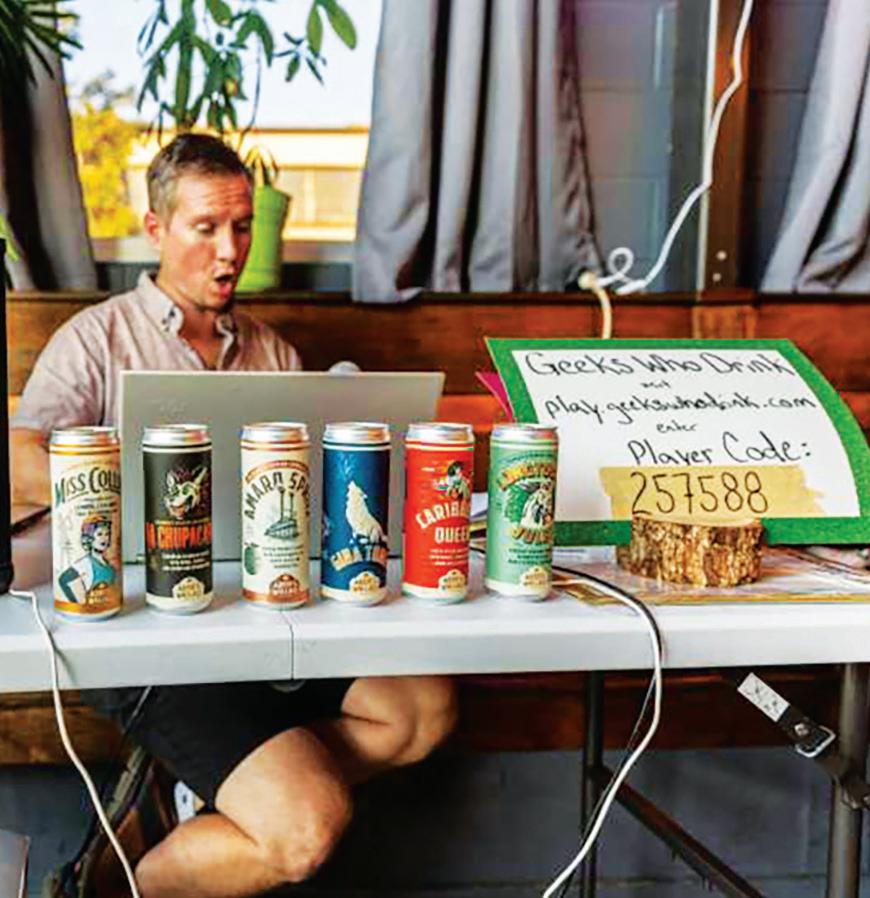
6:30-8:30 p.m. Thursday, Aug. 22, Abbott & Wallace Distilling, 350 Terry St., Suite 120, Longmont. Free
JY the Whiskey Guy hosts this weekly Geeks Who Drink trivia contest at Abbott & Wallace Distilling in Longmont. Teams of up to six can compete for round-byround and grand prizes — but since the pub kitchen is open until 8 p.m., everybody wins.

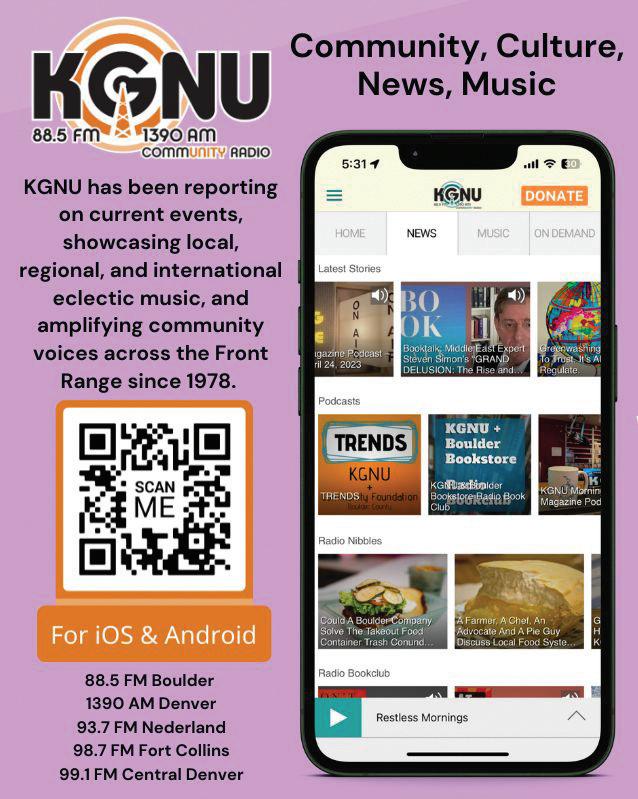
Rocky Mountain Institute, Inc. has multiple opptys in Boulder, CO for a Mngr, Climate Aligned Industries (Ref #7539099Provide technical assistance & policy advisory on country engagement efforts. Up to 15% domestic & 10% int’l travel req’d.)
Sr Associate (Ref #7390775Utilize quantitative, technical, & analytical abilities to conduct compelling research & assessment around clean energy solutions in the U.S. energy sector.) May wrk from our HQ office in Boulder, CO or reside anywhere in US & wrk remotely from home. May wrk at other US locatns not prsntly known.
Email resume w/Ref# to recruiting@rmi.org. Must be legally auth to work in the US w/o spnsrshp. EOE


THURSDAY, AUGUST 15
DENNIS WANEBO 6 p.m. BOCO Cider, 1501 Lee Hill Drive, Unit 14, Boulder. Free
WOLF LOESCHER. 6 p.m. Bricks on Main, 471 Main St., Longmont. Free
WELCOME BACK WITH BRUHA, VIOLET VISIONARIES AND ROSEBAY 7 p.m. Hi-Dive, 7 S. Broadway, Denver. $12
LIONEL YOUNG DUO. 8 p.m. Velvet Elk Lounge, 2037 13th St., Boulder. Free
THE MARIAS WITH AUTOMATIC. 8 p.m. Mission Ballroom, 4242 Wynkoop St., Denver. $123+
SIERRA FERRELL WITH NICK SHOULDERS 8 p.m. Mission Ballroom, 4242 Wynkoop St., Denver. $81+
RED LIGHT RITUAL WITH IN PLAIN AIR AND BITCH FLOWER. 8 p.m. Hi-Dive, 7 S. Broadway, Denver. $15
SATURDAY, AUGUST 17
DEREK DAMES OHL 6 p.m. BOCO Cider, 1501 Lee Hill Drive, Unit 14, Boulder. Free
MWEBAZA’S ANNUAL HOUSE CONCERT. 6 p.m. 1103 Collyer St., Longmont. $23
TYLER CHILDERS WITH SHAKEY GRAVES 5:30 p.m. Saturday, Aug. 17, CU BoulderFolsom Field, 2400 Colorado Ave. $78+ BW PICK OF THE WEEK



BILL MCKAY BAND 9 p.m. Southern Sun, 627 S. Broadway St., Boulder. Free
FRIDAY, AUGUST 16
SARAH BANKER 11 a.m. OZO Coffee Company, 1015 Pearl St., Boulder. Free
ZENARI 6 p.m. BOCO Cider, 1501 Lee Hill Drive, Unit 14, Boulder. Free
MAX MACKEY BAND. 6 p.m. Wibby Brewing, 209 Emery St., Longmont. Free
THE DREAM TEAM 6 p.m. Bricks on Main, 471 Main St., Longmont. Free
INGRID AVISON BAND. 6 p.m. Trident Booksellers & Cafe, 940 Pearl St., Boulder. Free
TIM OSTDIEK BAND. 6 p.m. Bootstrap Brewing Company, 142 Pratt St., Longmont. Free
MAD DOG BLUES WITH SPECIAL GUESTS. 7 p.m. Muse Performance Space, 200 E. South Boulder Road, Lafayette. $20
VON DISCO. 7 p.m. The Courtyard, 836 Main St., Louisville. Free
TWANG MOUNTAIN WITH BRANDYWINE AND THE MIGHTY FINES 8 p.m. Roots Music Project, 4747 Pearl St., Suite V3A. Boulder. $15
CHAIR BOMB. 6 p.m. Trident Booksellers & Cafe, 940 Pearl St., Boulder. Free
TERESA STORCH BAND 6 p.m. Bricks on Main, 471 Main St., Longmont. Free
THE SAINTS. 6 p.m. Bootstrap Brewing Company, 142 Pratt St., Longmont. Free
MUSIC AT MCINTOSH LAKE 7 p.m. Flanders Park, 2115 N. Shore Drive, Longmont. Free
PINETOP PERKINS BLUES SHOWCASE WITH BOB MARGOLIN. 7 p.m. Roots Music Project, 4747 Pearl St., Suite V3A. Boulder. $15+
TAYLOR SCOTT BAND WITH EL DOLOR 8 p.m. Velvet Elk Lounge, 2037 13th St., Boulder. $18
THE DESERT FURS. 8 p.m. Longs Peak Pub, 600 Longs Peak Ave., Longmont. Free
THE FRESH & ONLYS WITH FLAURAL, SNOWFLYER AND DJ RYAN WONG 8 p.m. Hi-Dive, 7 S. Broadway, Denver. $18
EXTRA GOLD 11 p.m. Boulder Theater, 2032 14th St. Free
JOHN R. MILLER 11:30 p.m. Fox Theatre, 1135 13th St., Boulder. $15

Kentucky-born country phenom Tyler Childers takes the stage at CU Boulder’s Folsom Field on Aug. 17. The Grammy-nominated artist performs in support of his latest album, Rustin’ in the Rain, out now via RCA Records. Check out an interview with opening act Shakey Graves on p. 17 before you go. See listing for details.
SUNDAY, AUGUST 18
LOCO UKULELE JAM 2 p.m. Bootstrap Brewing Company, 142 Pratt St., Longmont. Free
SHINE SWEET MOON. 4 p.m. BOCO Cider, 1501 Lee Hill Drive, Unit 14, Boulder. Free
HAMILTON LOOMIS 6 p.m. Bricks on Main, 471 Main St., Longmont. Free
O.A.R. WITH FITZ AND THE TANTRUMS AND DJ LOGIC. 6:30 p.m. Red Rocks Park & Amphitheatre, 18300 W. Alameda Parkway, Morrison. $218
LUCAS DAVIS QUINTET. 7 p.m. Muse Performance Space, 200 E. South Boulder Road, Lafayette. $20
KENNYTHEINDIGO 8 p.m. Velvet Elk Lounge, 2037 13th St., Boulder. Free
MONDAY, AUGUST 19
RED WANTING BLUE WITH GUEST
JUNO ROSSA. 8 p.m. Roots Music Project, 4747 Pearl St., Suite V3A. Boulder. $25+
TOGETHER PANGEA WITH LIILY 8 p.m. Marquis Theater, 2009 Larimer St., Denver. $33
TUESDAY, AUGUST 20
DAVE HONIG 6 p.m. Roadhouse Boulder Depot, 2366 Junction Place, Boulder. Free
THE NALANI EFFECT WITH REGI WOOTEN. 6:30 p.m. Roots Music Project, 4747 Pearl St., Suite V3A, Boulder. $15
THE STRUTS WITH BARNS
COURTNEY 8 p.m. Mission Ballroom, 4242 Wynkoop St., Denver. $50
WEDNESDAY, AUGUST 21
LOST PENNY. 6 p.m. Rosalee’s Pizzeria, 461 Main St., Longmont. Free
ROSELIT BONE WITH GEORGE CESSNA AND FLY JANET. 7 p.m. Hi-Dive, 7 S. Broadway, Denver. $18
CHUCK SITERO WITH DYLAN KOBER
8 p.m. Velvet Elk Lounge, 2037 13th St., Boulder. Free
KINGS OF PRUSSIA. 9 p.m. Southern Sun, 627 S. Broadway, Boulder. Free



Want more Boulder County events? Check out the complete listings online by scanning this QR code.
Businesses and Local Community, INVESTING IN THE ARTS IS IN YOUR BEST INTEREST

• Provide opportunities for artists to enrich and advance their careers
• Continue to build the NoBo Art District as an artistic and business destination
• Provide the community with events, education opportunities and creative outlets


BY ROB BREZSNY
ARIES (MARCH 21-APRIL 19): Some centenarians testify they have lived more than a century because they smoked many cigarettes, drank a lot of booze and ate a steady diet of junk food. Should the rest of us adapt their habits? Of course not. The likelihood of remaining healthy while following such an unsound regimen is infinitesimal. Just because a few lucky people miraculously thrived like that is not a sound argument for imitating them. I bring this to your attention, Aries, because the coming weeks will be an excellent time to upgrade your commitment to healthy habits. If you’ve been waiting for the right time to love your body better, this is it.
TAURUS (APRIL 20-MAY 20): Taurus stage magician Doug Henning had lavish ambitions. They served him well as he became a star performer in theater and on TV. “If I produce a 450-pound Bengal tiger,” he said, “it’s going to create a lot more wonder than if I produce a rabbit.” That’s the spirit I invite you to embrace in the coming weeks, Taurus. The cosmos is authorizing you to expand your understanding of what you can accomplish — and then accomplish it. Dream bigger dreams than you have previously dared.
GEMINI (MAY 21-JUNE 20): The color of planet Earth is predominantly blue with green, brown and white mixed in. And for people all over the world, blue is more often their favorite color than any other. Why? In part because blue typically evokes peace, tranquility, security and stability. It’s often used in therapeutic environments, since it makes us feel more at ease about expressing our feelings. I bring these thoughts to your attention, Gemini, because you are entering a blue phase of your cycle. It will be a favorable time to harvest the benefits of relaxing and slowing down. You are more likely to feel at home with yourself and accept yourself just as you are.
CANCER (JUNE 21-JULY 22): Harvard Business School professor Gerald Zaltman, born under the sign of Cancer, says that 95% of our buying choices originate in our subconscious minds. Behavioral psychologist Susan Weinschenk believes 90% of all our decision-making is unconscious. But I propose that in the coming weeks, you increase the amount of conscious awareness you bring to sorting out your options. Cosmic energies will conspire in your favor if you do. You will receive unexpected boosts and generate creative enhancements if you resolve to rouse more lucid analysis and careful thoughtfulness.
LEO (JULY 23-AUG. 22): A wealthy hedge fund manager named Raj Rajaratnam paid Leo singer Kenny Rogers $4 million to perform at his epic birthday party. But the night turned nightmarish for Rogers when Rajaratnam insisted that he sing his hit song “The Gambler” over and over again. Finally, after 12 repetitions, Rogers refused to do more. I wonder if you, too, might soon have to deal with a situation that’s too much of a good thing. My advice: Make sure all agreements between you and others are clear and firm. Get a guarantee that you will receive exactly what you want, and don’t do more than you have promised.
VIRGO (AUG. 23-SEPT. 22): Now and then, zoologists decide that their classifications of species need to be revised and refined. For example, three subspecies of softfurred, teardrop-shaped hedgehogs in Southeast Asia were recently elevated to a distinct species of their own. They are no longer considered to be a subspecies of Hylomys suillusbut, but are now named H. dorsalis, H. maxi, and H. peguensis. I bring this to your attention, Virgo, because I suspect that you, too, are ready for an upgrade to a new category all your own. It’s time for you to claim greater sovereignty. You will be wise to define how distinctive and unique you are, to distinguish yourself from influences that are superficially like you.
LIBRA (SEPT. 23-OCT. 22): When megafamous artist Pablo Picasso was asked how he felt about NASA landing people on the moon in 1969, he said, “It means nothing to me. I have no opinion about it, and I don’t care.” I invite you to use his statement as one of your power mottoes in the coming weeks. Now is an excellent time to identify the experiences, influences, events and people about which you have absolutely zero interest. Once you do that, I predict you will have a rush of clear revelations about the most interesting experiences, influences, events and people you want in your future.
SCORPIO (OCT. 23-NOV. 21): The ancient Chinese philosopher Lao-Tzu made an observation that could serve as your watchword in the coming months. “Being deeply loved by someone gives you strength,” he wrote, “while loving someone deeply gives you courage.” In my astrological opinion, Scorpio, you are now primed to embody and express these states with unique intensity. If you embrace the inspiring challenge of loving deeply and being loved deeply, you will reach new heights of strength and courage.
SAGITTARIUS (NOV. 22-DEC. 21): Many musical instruments must be constantly adjusted to ensure they stay in tune. This usually means that the note A above middle C vibrates at 440 cycles per second, with all other notes tuned in relation to it. Having sung in bands for years, I have seen how guitarists, bass players, violinists and even drummers have to continually attend to their tuning during performances. Imagine the diligent finesse it takes to keep an entire orchestra of many instruments in tune with each other. I suspect that one of your jobs in the coming weeks, Sagittarius, will have similarities to this kind of management and coordination.
CAPRICORN (DEC. 22-JAN. 19): Dancing is always good for you, but it will be extra healthy and energizing in the next four weeks. I hope you will be inspired to dance as often as possible, even if you just do it alone in your kitchen or bedroom while listening to music that moves you. Do you need rational explanations for why this is a good idea? OK, here are the hard facts: Dancing reduces stress, raises serotonin levels, enhances well-being and is excellent physical exercise. Here’s another motivational reason: Dancing literally makes you smarter. Scientific research clearly says so (tinyurl.com/SmartDancing). Furthermore: In the near future, you will be in a playful, sexy, exuberant phase of your astrological cycle.
AQUARIUS (JAN. 20-FEB. 18): “Quo signo nata es?” is the Latin expression for “What’s your sign?” Did anyone in ancient Rome ever say that? Probably not, since it’s a modern idiom. However, astrology was very popular in that society and era. According to scholar Rhianna Padman in her essay “Astrology in Ancient Rome,” Romans “believed that the specific positions of celestial bodies at the moment of a person’s birth could greatly impact their life and character.” Back then, Thrasyllus of Mendes was a prominent astrologer who became a key advisor to Emperor Tiberius. Anyway, Aquarius, I bring “Quo signo nata es?” to your attention so as to inspire the following assignment: Update all your old favorite things. Put new spins on symbols and ideas that have served you for a long time. Take the best parts of your traditions and transplant them into the future.
PISCES (FEB. 19-MARCH 20): The coming weeks will be an excellent time to declare amnesty about all matters affecting your close alliances. Dissolve grudges, please. Tussle less, play more. Relax your demands and expectations — and nicely ask your companions to relax their demands and expectations. If possible, forgive others and yourself for everything; failing that, forgive as much of everything as feels right. You might even convene a ritual in which you and your intimate collaborators chant the following affirmation: “We are gleefully free to reimagine and reinvent the ways we fit together!”
I’m a queer cis woman in my late 30s with a problem: I don’t like having my pussy eaten. At best, I get close but eventually plateau, which is frustrating. At worst, it feels slimy, like a slug exploring my genitals.
But the actual problem for me is modern men. They are obsessed with eating pussy and get very pouty when you don’t think it’s the best. I tried dating a couple of men who “don’t eat pussy,” but those men didn’t seem to care at all about getting a woman off. And while I’m queer, it feels like cunnilingus is even more important when you’re hooking up with other women/AFABs.
I feel like faking it with new partners and enjoying my actual orgasms alone would be easier than opening about this to new people. Being treated like a freak has turned sex, which is supposed to be fun, into something that makes me feel bad about myself.
Not everyone likes receiving oral! People are allowed to dislike things! Even things most people like! Being GGG means listening to people when they tell you what they like!
I hope that helps, WILL, but since PSAs never reach 100% of their target demo, you’ll still have to tell new partners you dislike receiving oral sex.
My partner and I have been dating for almost a year, and everything’s been amazing. He really wants me to get into anal play. Early in our relationship, we tried, but I was on a medication that made me nauseous, so it was unpleasant. I’m no longer on that medication. He hasn’t pushed the subject since, until the other day when he tried to insert a plug without much warning. I told him I need more comfort and preparation before we dive into that kind of play. I also confessed I’ve been dealing with some GI issues. He made it clear that he eventually wants to fuck my ass with his giant cock, and he seems to think I’m not trying hard enough. To be fair, I haven’t done much solo exploration with plugs. He mentioned that not progressing with anal could be a dealbreaker for him. Is that fair?
— Advice Negotiating Anal Leeway
BY DAN SAVAGE

Anything can be a dealbreaker — and Liz Lemon never said dealbreakers had to be fair. But dealbreakers cut both ways. Meaning, your partner is free to say, “I’m gonna break up with you if I can’t fuck your ass with my giant dick,” ANAL, but you’re free to say to him, “If you pressure me to do things that don’t feel good, I’m gonna dump your ass before we can figure out whether your dick feels good in mine.”
As prices of admission go, ANAL, having butt sex that doesn’t feel good is too steep a price to pay. Going without anal sex, on the other hand, is a price many have paid to be with someone they loved. If your “amazing” new partner with the giant dick isn’t willing to contemplate going without anal for you, he probably doesn’t deserve your ass. P.S. To make someone feel excited about exploring anal sex, you have to make them feel physically and emotionally safe. Shoving a toy into someone’s ass without warning is a great way to make them feel physically unsafe; threatening to break up with someone if they can’t take your giant dick up their ass is a great way to make them feel emotionally unsafe. If your boyfriend can’t see that he’s doing this all wrong, ANAL, it’s not just your ass he can’t be trusted with.
Email your question for the column to mailbox@savage.love. Podcasts, columns and more at Savage.Love

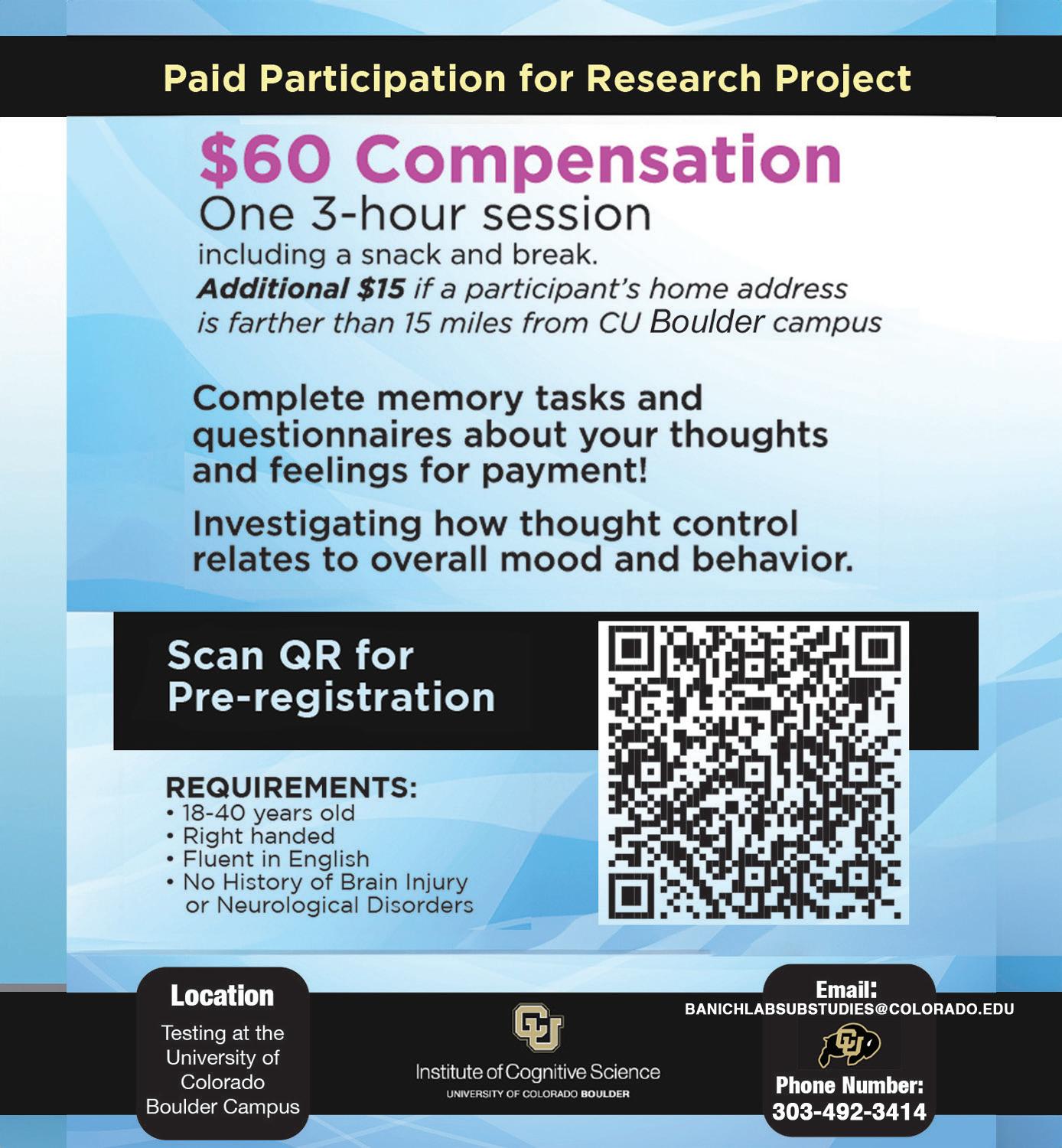












Two pie guys share the secrets of baking the perfect Colorado peach pastry
BY JOHN LEHNDORFF
Like other types of nerds, pie geeks have their own peculiar lingo. When they meet, conversations are laced with words like slurry, lattice, crimping and venting — to say nothing of the heated debates about butter vs. lard vs. Crisco.
“Everything’s better with butter,” argues John Hinman. “The only thing in my crust is chilled butter, ice water, AP [all-purpose] flour and salt.”
The first time I met Hinman, he had entered a Denver pie contest I was judging. His flaky crust was excellent; his entry won.
“The real secret is not overmixing it,” he says. “I throw everything in the food processor.”
Hinman knows pie, and so do I. Hinman has become one of Colorado’s most notable piemakers.
His Denver-based Hinman Pie bakery hand-crafts thousands of full-size and hand pies weekly. They are available at local grocers including Lucky’s Market, at the Saturday Boulder and Longmont Farmers Markets, and at Aug. 19’s Lafayette Peach Festival.
I was chief judge at the National Pie Championships and executive director of the National Pie Council.
We agree on a lot. You need to refrigerate pie dough uncovered for at least a few hours before rolling. You also don’t need perfect-looking fruit to make pies: Ask for “seconds” and save some money.
Finally, peach pies need to “age” on the kitchen counter for two to four hours after baking so they reach their full-flavored and sliceable potential.

Colorado orchards supply dozens of peach varieties ranging from suncrests to red globes that change almost weekly until the season ends. They each reveal unique flavor, sweetness and juiciness profiles.
This year has been a good one for Colorado peaches, with a bounty of fresh fruit flowing into local stands and supermarkets. These sweet globes are begging to be tucked inside a pastry.
While I’m a Colorado peach purist using only the firm and juicy fruits grown in this state — Hinman’s pies are half Colorado, half California.
“I use as many peeled Ella Farms peaches as I can,” he says, “but the local fruit is very juicy.”
Hinman likes to bake in thin aluminum tins. I use glass pie pans because I can lift it and tell if the bottom is properly baked. In my decades of judging pie contests, a soggy bottom was a common attribute of losing entries.
My secret is to divide the fruit for a pie. I put half the sliced peaches over the bottom crust. After cooking the second half with the other filling ingredients — cornstarch (or powdered tapioca), a little sugar and spices — pour it over the fresh fruit and crown with crust, a lattice or a crumb topping.
Hinman perfected his hand pies working for several years at The Post Brewery in Lafayette when the restaurant first opened. He makes them using the same dough he has on hand for large pies.
day achieve baking greatness.
“I really wanted to come up with a better pie than the Hostess or Marie Callender’s pies that were everywhere,” he says. “That’s when I entered that pie contest.”
For Hinman, pie is a healing and spiritual practice as well as a business and a dessert.
“Pies have no sides,” he says. “In this era we’re getting through, the best thing you can do is simply give someone a pie.”
I retired from judging pie contests three years ago because, frankly, it’s not really healthy to taste 25 pies in a couple of hours.
“You put just enough filling on the crust round and brush the edges with egg wash,” he says. “Then you fork a crimp around the edges to seal them.”
For two pie experts, our first pie memories are embarrassingly commercial. My first pie was probably a mini blueberry pie from Table Talk Pies, made in Massachusetts.
As for Hinman, he says, “My first pie memory was eating a Hostess Fruit Pie when I was a kid in New York.”
But that experience inspired him to one
However, I’m making an exception for my favorite competition: the Louisville Homemade Pie Contest on Sept. 2. The contest in Memory Square Park had been on hiatus since the pandemic. After I judge the Best of Show pies, attendees can taste the contest pies and disagree with the judges.
The youth pie makers are precious and give one hope for pie’s survival.
To enter a pie in the Louisville Homemade Pie Contest: bit.ly/ LouisvillePieBW. Try John Lehndorff’s tested pie crust recipe online at bit.ly/ CrustyBW.


Boulder’s Sanitas Brewing Co. has opened its third taproom at 400 W. South Boulder Road in Lafayette, filling the former Front Range Brewing Co. space. Besides 18 taps and a big patio, the brewery features a lunch and dinner menu developed by the neighboring Kenny Lou’s Deli For the 41st year in a row, Boulder’s Flagstaff House Restaurant is a Wine Spectator Grand Award winner.



USA Today has named Colorado’s Grand Valley as one of the Top 10 wine regions in the country to visit.

Ginger & Baker in Fort Collins offers an Aug. 25 class in crafting lemon meringue pies and peach hand pies. Register: gingerandbaker.com
Acreage by Stem Ciders in Lafayette hosts a behind-the-scenes cider tour Aug. 21 featuring sips of cider straight from the barrel, warm pretzels, a flight of ciders and a cider glass to take home. Reservations: acreageco.com













The 44th annual Telluride Mushroom Festival takes place in the mountain town Aug 15-18. Tickets: tellurideinstitute.org

“Apple pie. Apple fritters. Apple puffs, Southern style. Peach cobbler, Southern style. Peach pie. American mince pie. Pumpkin pie. Squash pie. All sorts of American pastry.” — Mark Twain, writing about what he missed from America, in A Tramp Abroad
John Lehndorff hosts the Global Pie Society Facebook group. He is the former chief judge at the National Pie Championships, executive director of the American Pie Council, and director of the Great American Pie Festival. Comments: nibbles@boulderweekly.com









FDA rejects first application for drug despite 71% efficacy
BY NIKO SKIEVASKI

On Friday, the U.S. Food and Drug Administration (FDA) did not approve MDMA-assisted therapy to treat post-traumatic stress disorder (PTSD) even after clinical trials demonstrated efficacy in 71% of participants.
While not a total denial, the FDA issued a complete response letter (CRL) requesting a new phase 3 trial in response to the new drug application submitted by Lykos Therapeutics. Lykos is a public benefit company formed by the nonprofit Multidisciplinary Association for Psychedelic Studies (MAPS) that has been leading research and advocacy in the space since MDMA, also known as ecstasy, was made illegal in the 1980s. While the contents of the letter have not been released, Lykos shared a statement late Friday.
“The FDA request for another study is deeply disappointing,” wrote Lykos CEO Amy Emerson, “not just for all those who dedicated their lives to this pioneering effort, but principally for the millions of Americans with PTSD, along with their loved ones, who have not seen any new treatment options in over two decades.”
This news was not a complete shock to the company, which had been bracing for a negative response since an FDA Advisory Committee voted 11 to 1 in June that benefits would not outweigh its risks.
Primary concerns from the committee focused on the design of the clinical trials. Participants were unblinded, meaning they likely knew if they had taken MDMA. Additionally, 40% of participants had prior experience with the drug, creating an expectation bias that could have augmented results.



While the phase 3 clinical trial reported that 71.2% of participants no longer met the diagnostic criteria for PTSD after 18 weeks, so too did 47.6% of the placebo group. The placebo group sat in the same extensive therapy setting as those who received MDMA, but received a sugar pill instead.
One of the innovations in using psychedelics in mental health is the power of these drugs to augment therapy, allowing patients to become more receptive to the insights and perspectives that could promote healing.
“Many individuals with PTSD experience difficulties participating in psychotherapy due to the requirement that they revisit their trauma multiple times,” said Dr. Neill Epperson, chair of psychiatry at CU Anschutz Medical Center, in an interview with Boulder Weekly. “Being able to face these experiences with the support of MDMA, in addition to a trusted therapist, can allow individuals to face their fears and see their trauma in a new light, one in which they do not feel like they are to blame for what has happened to them.”
The FDA was tasked with evaluating the efficacy of therapy enhanced by MDMA, not the drug on its own. However, the U.S. regulatory model gives the FDA jurisdiction on approving drugs, not psychotherapy, which is not regulated by any federal agency.

“Therapy is necessary in combination with MDMA because it helps clients to prepare for their journey, guides them through the actual medicine experience, and then works with the client in an ongoing fashion to integrate their psychedelic experience, helping them to process it, understand its significance, and apply these insights to daily life in the form of goals and actionable plans,” Ken Weingardt, PhD, a clinical psychologist who served in the Department of Veterans Affairs for nearly 20 years, wrote in response to emailed questions.
Beyond Lykos, there are dozens of drug companies attempting to gain FDA approval of other psychedelic compounds. Lykos was the first to complete clinical trials and submit an application to the FDA.
Lykos will appeal the decision with regulators but may eventually need to conduct another clinical trial at great expense, likely taking years to complete. For now, those suffering from PTSD will have to lean on decades-old approaches that have shown modest relief for the often debilitating symptoms.
In the company’s statement, Emerson wrote, “Our heart breaks for the millions of military veterans, first responders, victims of sexual and domestic abuse and countless others suffering from PTSD who may now face more years without access to new treatment options.”
Niko Skievaski (niko@altheapbc.com) is a Boulder resident and co-founder of Althea PBC, a software company seeking to support the regulated rollout of psychedelics in Colorado. He served on Denver’s Natural Medicine Work Group.


























































































































